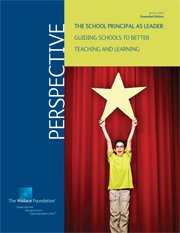The Principal Story Learning Guide
To advance the professional learning of aspiring and current school leaders

Facilitators: Adult learning professionals may use this web-based learning tool in principal preparation courses or in workplace study sessions. Facilitators may encourage participants to take advantage of the writable PDFs to record and save their responses. For onsite study groups or classes, the facilitator may choose to print relevant worksheets and provide them to participants. Depending on class structure and learning goals, facilitators will use these tools to provide group and individual learning experiences within the following structure:
Consider ideas and connect with others
Think about the role of a school principal in cultivating leadership in others. Independently, respond to questions on the worksheet and exchange responses with a partner. Connect with others, if applicable, to discuss common themes.
- What does it mean for principals to cultivate leadership in others?
- What examples or results of cultivating leadership can you share from your own experience?
Watch the film clip
View a clip on cultivating leadership in others to see research in practice. Use the Big ideas chart to guide independent note-taking while viewing.
In this clip, viewers observe Principal Kerry Purcell (Harvard Park Elementary) participating in an end-of-year team meeting as she develops capacity for learning and leading. While modeling her thought process, expectations, and beliefs for her teachers, she also holds learning as a top priority for teachers and students. [Time: 3 minutes, 5 seconds]
Read the excerpt
The School Principal as Leader: Guiding Schools to Better Teaching and Learning (The Wallace Foundation, 2013), 9-10.
Download excerpt in PDF format.
A broad and longstanding consensus in leadership theory holds that leaders in all walks of life and all kinds of organizations, public and private, need to depend on others to accomplish the group’s purpose and need to encourage the development of leadership across the organization.1 Schools are no different. Principals who get high marks from teachers for creating a strong climate for instruction in their schools also receive higher marks than other principals for spurring leadership in the faculty, according to the research from the University of Minnesota and University of Toronto.2
In fact if test scores are any indication, the more willing principals are to spread leadership around, the better for the students. One of the most striking findings of the universities of Minnesota and Toronto report is that effective leadership from all sources — principals, influential teachers, staff teams and others — is associated with better student performance on math and reading tests.
The relationship is strong albeit indirect: Good leadership, the study suggests, improves both teacher motivation and work settings. This, in turn, can fortify classroom instruction. “Compared with lower-achieving schools, higher-achieving schools provided all stakeholders with greater influence on decisions,” the researchers write.3 Why the better result? Perhaps this is a case of two heads — or more — being better than one: “The higher performance of these schools might be explained as a consequence of the greater access they have to collective knowledge and wisdom embedded within their communities,” the study concludes.4
Principals may be relieved to find out, moreover, that their authority does not wane as others’ waxes. Clearly, school leadership is not a zero-sum game. “Principals and district leaders have the most influence on decisions in all schools; however, they do not lose influence as others gain influence,” the authors write.5 Indeed, although “higher-performing schools awarded greater influence to most stakeholders… little changed in these schools’ overall hierarchical structure.”6
University of Washington research on leadership in urban school systems emphasizes the need for a leadership team (led by the principal and including assistant principals and teacher leaders) and shared responsibility for student progress, a responsibility “reflected in a set of agreements as well as unspoken norms among school staff.”7
Footnotes
1. See for example, J.W. Gardner, On Leadership, The Free Press, 1993; J. Kouzes, J. and B. Posner, The Leadership Challenge: How to Keep Getting Extraordinary Things Done in Organizations, Jossey-Bass Publishers, 2008; and G. Yukl, Leadership in Organizations, Prentice-Hall, 2009.
2. Karen Seashore Louis, Kenneth Leithwood, Kyla L. Wahlstrom and Stephen E. Anderson, Learning From Leadership: Investigating the Links to Improved Student Learning: Final Report of Research Findings, University of Minnesota and University of Toronto, 2010, 81-82.
3. Seashore Louis, Leithwood, 35.
4. Seashore Louis, Leithwood, 35.
5. Seashore Louis, Leithwood, 19.
6. Seashore Louis, Leithwood, 35.
7. Michael S. Knapp, Michael A. Copland, Meredith I. Honig, Margaret L. Plecki, and Bradley S. Portin, Learning-focused Leadership and Leadership Support: Meaning and Practice in Urban Systems, University of Washington, 2010, 3.
Complete the activities
Working in small groups or at their own pace, learners observe, discuss, engage, and reflect on the ideas and information presented in the film clips and related materials. Follow these links to tools that include writable PDF files to support this work.
About
The Principal Story Learning Guide
Required Text
The Wallace Foundation. (2013). The school principal as leader: Guiding schools to better teaching and learning. New York: Author.
Optional Texts
Mendels, P. (2012, February). The effective principal. JSD, 33(1), 54-58.
Seashore-Louis, K., Leithwood, K., Wahlstrom, K., & Anderson, S.E. (2010). Learning from Leadership: Investigating the Links to Improved Student Learning. New York: The Wallace Foundation.
THE PRINCIPAL STORY
Offered in
collaboration with:





